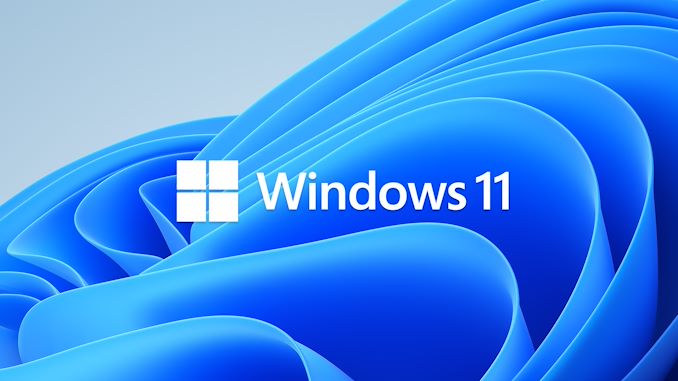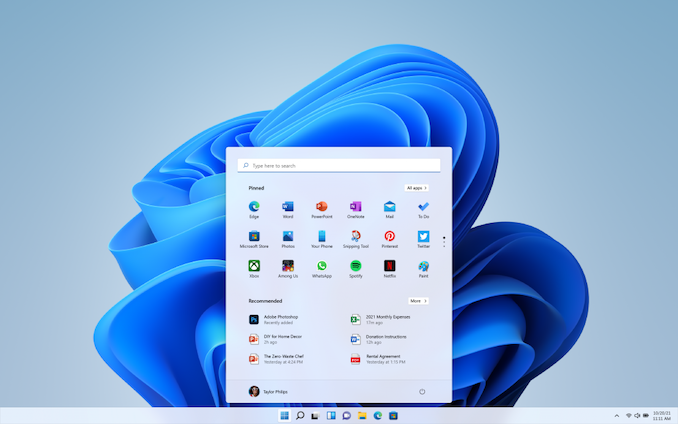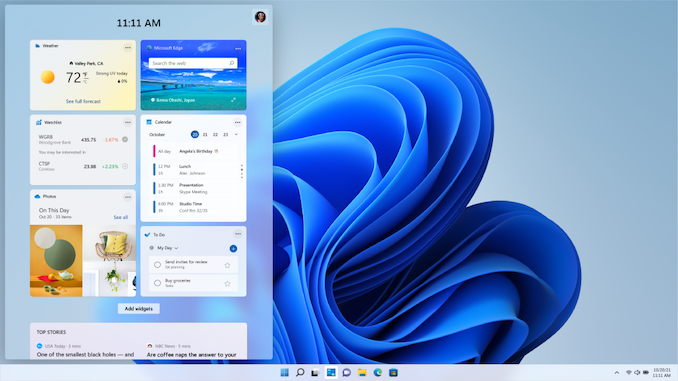What to Expect with Windows 11: A Day One Hands-On
by Brett Howse on October 4, 2021 4:00 PM EST- Posted in
- Software
- Operating Systems
- Windows
- Microsoft
- Windows 11

Tomorrow, Microsoft is officially launching Windows 11, the next installment of their operating system which underpins the majority of PCs in use today. Windows 10 has an install base of over 1 billion devices, and Windows 11 comes into existence in a much different place than its predecessor. After the much-maligned Windows 8 there was a sense of urgency and necessity which ushered Windows 10 into the world. Windows 11, on the other hand, comes into a market where most people are happy with Windows 10. So it raises the question: Why now?
When Windows 10 launched, it was said to be the final version of Windows, and future updates would be additive to Windows 10, rather than a new version number. But that was six years ago, and times have changed, as has the management and ownership of the Windows development team at Microsoft. For better or worse, the company has deemed that now is a good time to do a clean break again, with all of the animosity and angst that will bring to a good portion of their customers, especially businesses who may still be in the process of migrating to Windows 10.
The question is why now? What is new? Why is Microsoft choosing this moment to switch from the very successful Windows 10 and implement another upgrade cycle? Some of these questions can be answered, but others will take time.
Refreshed User Interface
The immediate change that everyone will notice is that Microsoft has completely revamped the user interface for Windows 11. They have apparently gotten tired of their obsession with flat, stark interfaces and moved to a much more colorful and expressive theme.
There are also major changes to the Start Menu and the taskbar. The Start Menu has ditched the live tile idea. Although a good idea on the now defunct Windows Phone platform, live tiles never really worked well on the desktop and could make it more difficult to find the application you were looking for since the icon would change. Instead, the Start Menu goes back to basic app icons, but now with the Start Menu, by default, centered in the middle of the display.
Live tiles have been replaced with Widgets and can be accessed via a Widget icon on the taskbar. Currently the selection of Widgets is only Microsoft ones, and it will be interesting to see if this expands over time.
Tablet Mode is now gone as well, so if you liked to use Windows 10 in its more touch-friendly mode, you will likely be disappointed.
The taskbar also moves from a left-justified look to being centered, and when more applications are opened, the icons already on the task bar will shift to the left to keep things centered. Apps can also no longer customize areas of the taskbar.
The taskbar can also no longer be moved from the bottom of the display if you were someone who liked to slide it to one of the other sides of the screen, which will likely disappoint a lot of people. When your user base is over 1 billion, if even only 1% of users used a feature, that’s still 10 million people that used that feature.
Overall, the new user interface is clean, colorful, and breathes some new life into what had become a bit stale in Windows 10. Functionally, it is not drastically different than Windows 10, although moving the Start Menu from the bottom left corner where it has been since Windows was first Windows is a bold change. The loss of Live Tiles seems like a downgrade in functionality, but it does make the interface more consistent and easier to access the applications you are looking for, with widgets hoping to take up the slack. But, there is a surprising amount of customization and features that are being dropped.












95 Comments
View All Comments
cc2onouui - Wednesday, October 6, 2021 - link
Sorry.. this is where my comment should beWell I'm with you on the fact that android is a complete garbage compared to windows, Linux on the other hand is only a failure on a adoption, the OS have nothing to do, DirectX "and" MS support for windows apps developers is an important key factor, no matter what a superior Linux you build the users will not give up their games and apps library, games developers rarely consider Linux, the shitty android has a big store you can't ignore, a device with android installed is a shame on a compute machine, Apps stores density decides what share an OS will take, most people will buy even Xbox "one" instead of a cheaper PS5 if PS5 has only one game
Oxford Guy - Monday, October 4, 2021 - link
‘Linux has been a catastrophic failure, capturing only 2% market share’Consumers have been the failure, allowing monopolies and duopolies to shake them down with asinine releases like this one.
flyingpants265 - Monday, October 4, 2021 - link
Agreed, but "consumers" are just normies, they are mostly the people you see working at Subway and commenting on YouTube. Increasingly moreso as people make more money and the internet is integrated more into everyday life. It's the eternal september again, v2 or v10 (not sure). Large companies make the decisions about what to put out, and consumers will buy and enjoy whatever they are told to buy (whatever's available, within certain limits). 99% of people well tell you "Heh heh I don't care" and some will make a big point about how pointless it is to spend your time worrying about this stuff, they just want an iPhone.Oxford Guy - Wednesday, October 6, 2021 - link
The humour is that the same thing that causes pseudo-communism to fail causes this pseudo-capitalism to fail.AnnonymousCoward - Wednesday, October 13, 2021 - link
I tried installing Linux on my desktop one time. The graphics barely worked, sound didn't work at all, and the Linux guru helping me couldn't easily figure it out and started searching on forums. I went back to Win95 and everything simply worked perfectly including WinAMP and music.jtiller90 - Thursday, October 14, 2021 - link
funny maybe you should try it againI have been trying linux kubuntu and installed steam and proprietary nvidia drivers and have been playing Doom Eternal with RTX enabled without any problems
Strangely Kubuntu Plasma desktop looks very similar to win 10 and 11 if you want Apple style go with Ubuntu
I also have Linux Manjaro with KDE plasma desktop and similar experiance to Kubuntu
again playing most of my steam games witout degredation
but this was not the case just 2 years ago.
relux - Monday, October 4, 2021 - link
Although I’m not as over-the-top about disliking Windows, I also experienced the calculator no longer working around Windows 10 1903.It’s worth noting that Server 2016, 2019, and 2022 Datacenter are all available for free to students and faculty with a .edu email address through Azure, and I find these to be faster and more stable than the mainline Windows releases.
However, on desktop systems with more than 64 logical processors, it’s worth noting that much otherwise “embarrassingly parallel” binary software cannot make use of the hardware due to Windows processor groups (and by extension the fact that legacy programs are not processor group aware). If these programs cannot be compiled again due to missing dependencies, etc. then Linux is the only viable option for exploiting this hardware. So, while Linux is a failure in the desktop market as you say, the underlying system is much more scalable than Windows has proven to be thus far.
coburn_c - Monday, October 4, 2021 - link
Yeah it's a lot easier to break backwards compatibility when you don't really have any functionality worth saving.Threska - Monday, October 4, 2021 - link
Virtualization and VFIO are still a thing. One can gain the advantages of both OS.flyingpants265 - Monday, October 4, 2021 - link
How's 2022 datacenter?